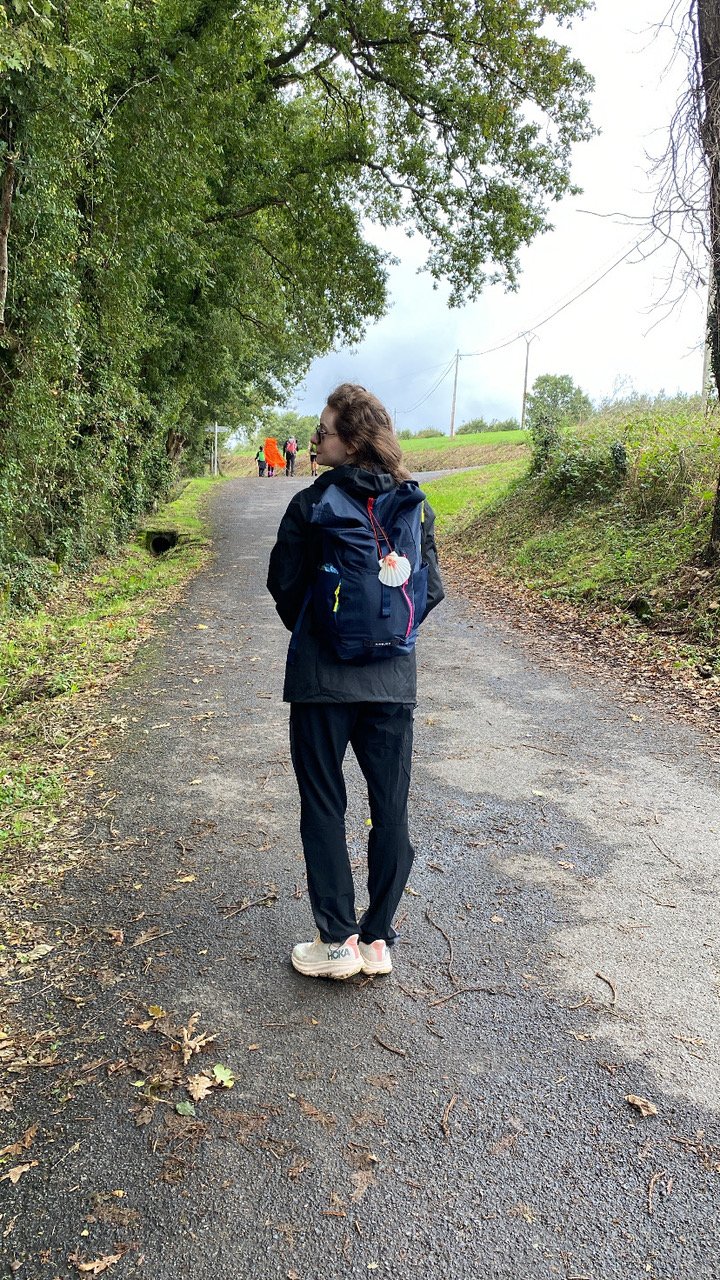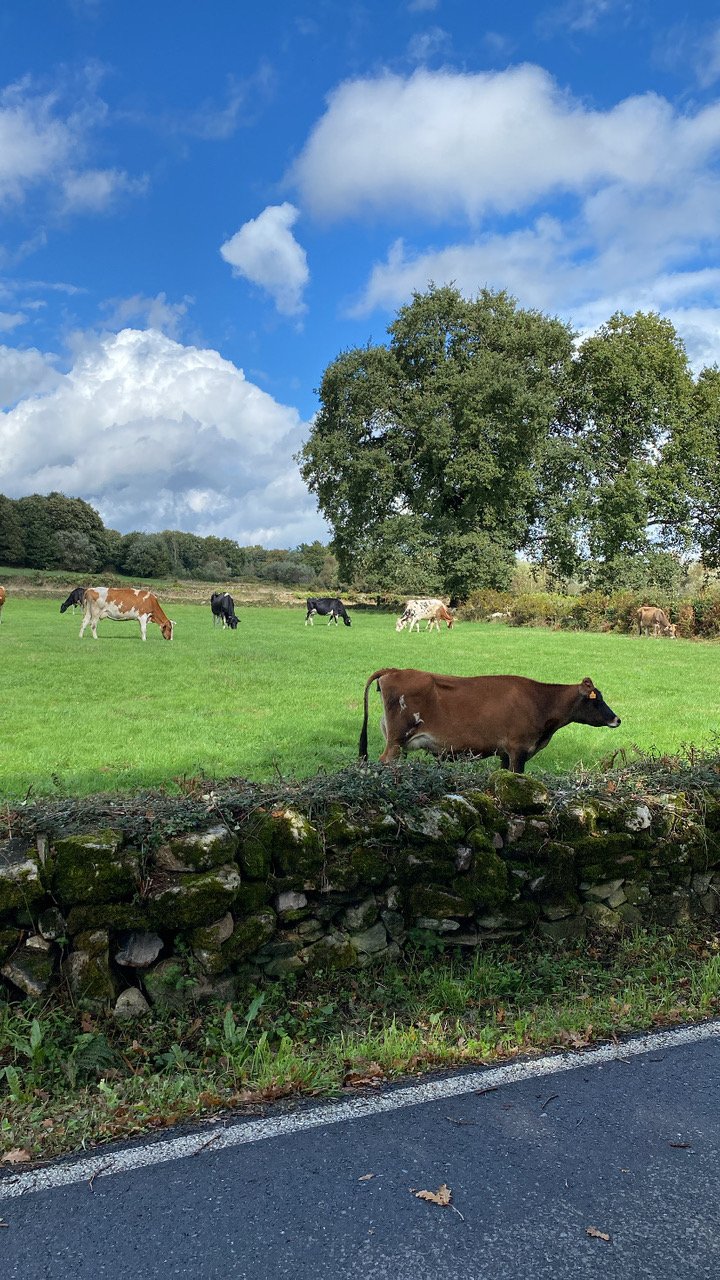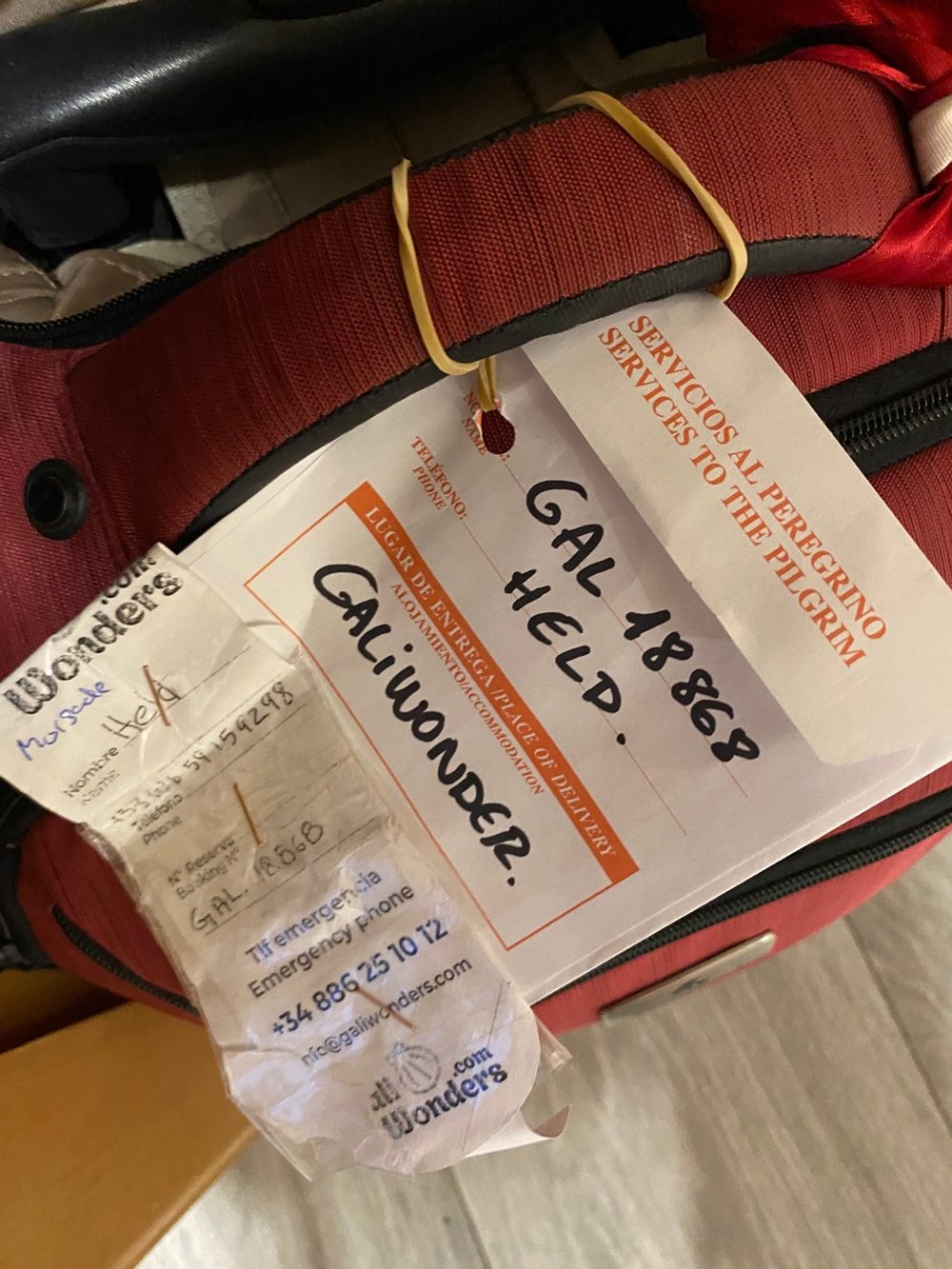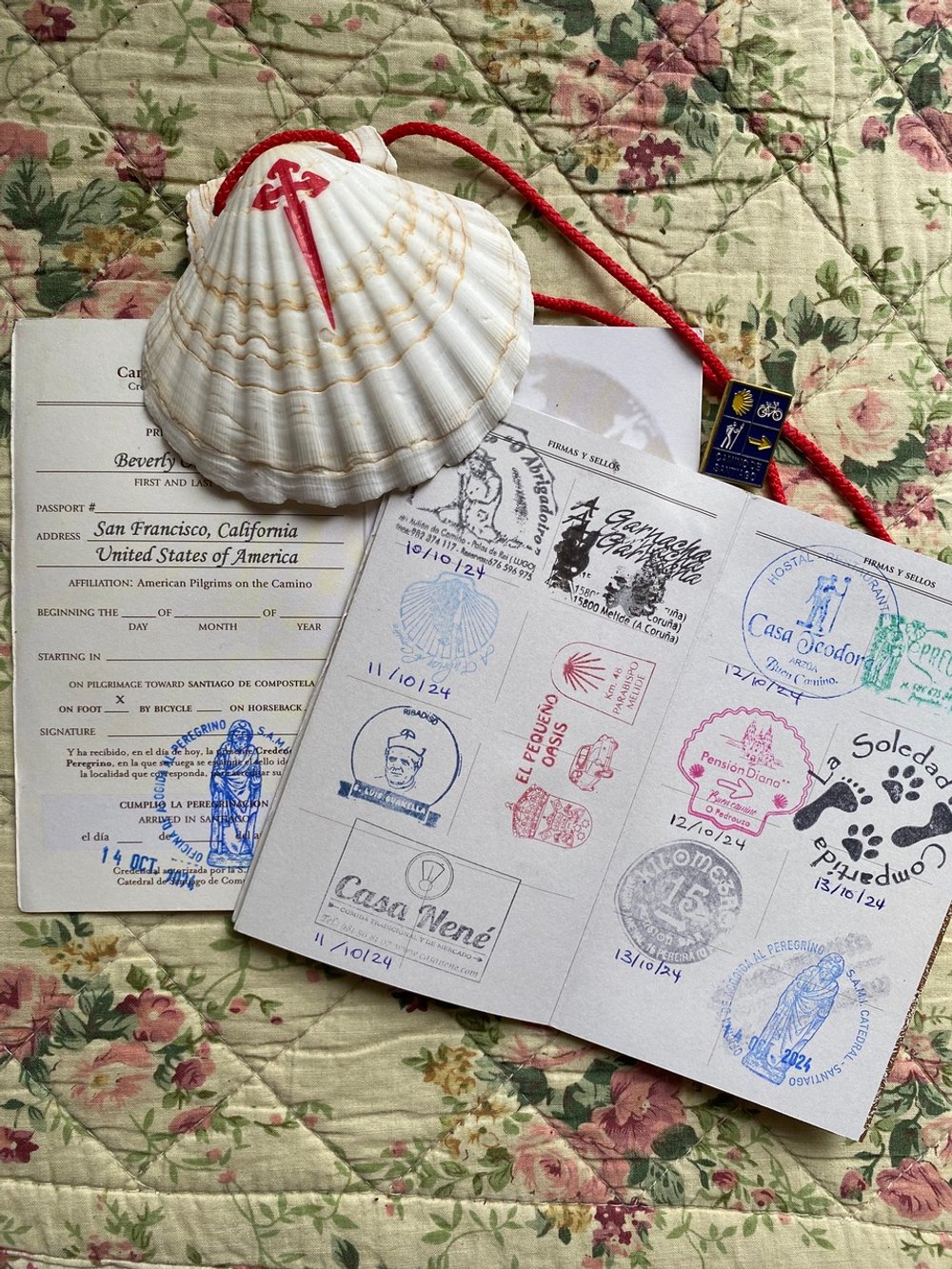Walking the Walk
Camino de Santiago de Compostela
Bienvenue and welcome back to Musée Musings, your idiosyncratic guide to Paris and art. I’ve been busy since I’ve been back in Paris, seeing temporary exhibitions all over the City. I’ll tell you about what I saw and what they meant and what you should see if you are here, over the next few weeks. This week it’s the Camino.
To be honest, I was having a difficult time figuring out how to begin, how to start the journey of telling you about walking the Camino. I know, just take the first step and that will lead to the next one and the one after that. The truth is that the actual walking didn’t require much thought. It really was just one foot in front of the other, over and over again. On smooth paths and cobbled ones, up hills and down, through small villages, in the woods, along the highway. (Figs 1 - 6) It was that simple because after choosing which route to take (the French Way) and where to begin (Sarria) to qualify for a certificate when we arrived in Santiago, there was nothing left to decide.
Figure 1. Ginevra starting the Camino in Sarria
Figure 2. Beverly on the Camino on a sunny day
Figure 3. We walked through some lovely villages with old stone buildings
Figure 4. Vista along the Camino
Figure 5. Cows were often there to greet us
Figure 6. We saw structures like this everywhere. They are to dry corn.
I have been wanting to walk the Camino for a long time. I ‘m not sure how long exactly, but my resolve was rekindled about 10 years ago when I saw a documentary at our little neighborhood movie theatre. The film followed the journeys of six sets of travelers. Among the walkers was one woman who used her walking sticks as canes. Whose knees hurt so badly she could barely walk. We listen to her call home, in tears, worried that she will have to abandon her trip. Another woman starts out with an enormous backpack. She talks about getting rid of everything but the clothes on her back. Which she eventually comes very close to doing. My favorites were two older guys. Who walked from one hotel to another, each hotel with private bedroom and bathroom. No hostel accommodations for them. No waiting in line to use the toilet or brush their teeth. No monks washing their feet at the end of the day, either. These guys traveled light, with one day pack between them.
It was the journey of those two guys that finally convinced me that an ‘authentic’ Camino is anything you want it to be. And it was my description of their journey that convinced Ginevra to walk the Camino with me. Plus my friend Caroline had walked a bit of the Camino last year. And Barb had walked another portion of it a few years ago. Their experiences offered two possible models. Barb, since she was alone, chose to be part of a small group, walking at their own pace but with a leader who knew everyone’s whereabouts. Independence with a safety net. Caroline and her friend booked their own hotels and organized their own luggage transfers.
We hadn’t been planning to walk the Camino. In fact, we had been talking about going to a spa. We wanted to put touring on hold for awhile, since we were still reeling from the crowds in Florence last year and in Venice the year before. I was able to convince Ginevra that walking was the closest thing to a spa experience and that when we got to our destination, we could book massages.
At first we planned to follow Caroline’s lead - study a map, determine distances, select a route and find hotels along that route. Then choose a company to transport our luggage from hotel to hotel. But it was January and most of the hotels on the Camino were closed. None answered our calls, none responded to our emails. It was too early to start making reservations. We could have tried again in March or April but I would have been in Paris, communicating with my Camino partner through emails, texts and telephone calls, which with the 9 hours time difference, is always a challenge.
So we decided to find a company to make hotel reservations and organize luggage transfers. We didn’t want to walk with a group, we just wanted our accommodations booked. Having an emergency number to call if a hotel didn’t have our reservation when we arrived or if our luggage was not waiting for us when we got there, or if we somehow got stranded or lost along the way, was also very appealing I think the company we found, Galiwonders which is based in Santiago, is a subcontractor for many other companies. Those companies had two set routes from our starting point, a challenging one and a leisurely one. I wanted a mix. Galiwonders was the only company willing to let me create my own itinerary. Our Camino was not a stressful one in the way that someone carrying a backpack with no idea of where they will be sleeping that night, is. But there were other stresses in store for us.
On my Air France flight from San Francisco to Paris last January, two films on the Camino were among the offierings. The Way, from 2010 and Camino from 2023. In the opening scenes of The Way, a portly Martin Sheen is playing golf, going from hole to hole on a golf cart. And then, without any preparation, he walks the entire French Way! From the Pyrenees! To honor his son who died at the beginning of his walk. Hardly plausible. The 2023 film Camino is Danish. An estranged man and his daughter walk the Camino to honor the last wish of wife/mother who hoped the trip would bring them together. Both films were about people walking the Camino as I initially imagined it had to be walked, with backpacks and without reservations. Was their Camino more authentic than mine was going to be? I decided I didn’t care.
The day before our Camino began did not start well. The taxi driver who took us from Paris to CdG airport rode the brake the entire time. The stops and starts on the highway made Ginevra sick even before we got on the plane! Toward the end of the flight itself, the plane entered an empty pocket and after minutes of turbulence, the plane went into a few endless seconds of free fall. (Fig 7) That experience was so unsettling, I began to dread the flights that awaited us after the Camino. I hate flying.
Figure 7. A selfie on the plane before it went into a free fall
At the airport, there was a driver waiting for us. Here is the irony of that. The driver picked us up at our destination and drove us to our starting point. It took a little less than 2 hours. It would take us 8 days of walking to get back to where we started. Which is definitely NOT how pilgrims of olde got to Santiago! We were modern pilgrims using airplanes and taxis to get us to where we began our Camino.
We chose the hotel where we stayed that first night. It was a hotel geared to large groups. After our two taxi rides and one airplane adventure, waiting 90 minutes for a dinner that never arrived seemed par for the course. It sure took the Buen out of Buen Camino!
A year of walking increasingly longer distances, initially when we were together in San Francisco during the holidays and then separately throughout the year, meant that by the time we were ready to begin our walk, we were worried that our short days of walking would too short! Also our Hokas, (shoes) which are the equivalent of walking on air. They gave me the confidence to tackle whatever terrain I would be confronting.
So, we decided that on the days of our short walks, we would wake up late, have a leisurely breakfast and explore the town before we left. That way, when we arrived at our destination, our room would be ready. Then we learned when our luggage had to be in the hotel lobby. And that breakfasts were geared to early rising pilgrims. We didn’t have to leave until 11, but our luggage had to be in lobby, ready to leave, every morning by 8 and breakfast was over by 9.(Figs 8, 9) And then there was this. Not all of the hotels were in charming towns or adorable villages. Sometimes there was nothing, well not much, to see those mornings.
Figure 8. The luggage tag that flawlessly got our luggage to and from 9 hotels
Figure 9. Ginevra at breakfast at 8:30 a.m.
We spent our first night, before the first day of walking, in a large town called Sarria. (Fig 10) We did wander around the town the next morning. By intention, I did not buy food to take with us. Because I wanted our walks to be sociable, I wanted to meet other pilgrims. I knew that wouldn’t happen at bars because we don’t do bars. I didn’t think it would be while we were walking, because everyone’s walking pace is different. Since we weren’t staying at hostels, that eliminated another way of meeting people. Where I hoped to chat with others was at the cafes where we stopped for lunch.
Figure 10. Shells on the bridge in Sarria over which we walked to begin our Camino
On our first day of walking, a short 12 km, we left Sarria for Morgade at about 11:30. With neither food nor drink because I’m a fast flat walker. I mean, I walk fast on flat surfaces. This walk had lots of hills that slowed me down. When we started to get hungry at about 1:00 p.m. ,we started to notice that all the cafes we were walking by were closed. Instead of places to eat and mingle, there were huts with vending machines! So we walked on, without food or water, for another couple of hours, mostly uphill with the occasional steep descent. We finally got to our destination, the Casa Morgade, at 3:00 p.m. I was more than just hungry. Thank goodness its simple restaurant was open, filled with backpackers walking to the next town.. The setting was rustic, the lunch was ample and delicious.
Intense hunger and nothing to eat reminded me of an interview I heard many years ago on NPR’s ‘All Things Considered’. I don’t remember the context but I do remember a woman who lived in Los Angeles telling the interviewer that she always had a sandwich in her purse because when she was girl, she had been deported to Auschwitz. The memory of unbearable hunger had never left her. That interview stayed with me, haunted me. Since then I have always carried something to eat. Except on the first day of the Camino. After that, we always had nuts, fruit and water with us.
Dinners were different. Starting with Casa Morgade, and for some reason I can’t remember now, the woman answering the emergency line of Galiwonders while we were walking, gave us suggestions for where to eat dinner each night. We ate well at all the restaurants she recommended. Here are a few highlights of some really great meals. (Figs 11 - 18) The two things my friend John told me his friends had the most trouble with - feet and food - were not the problems we encountered.
Figure 11. Casa Morgade. After a late lunch, we weren’t hungry for a big dinner. We had a simple salad and this toast of pepper jam, cheese and anchovies, suggested to us by Galiwonders. We never found it again, I dream about it.
Figure 12. Also at Casa Morgade, this heaping plate of padron peppers in quantities we never saw again.
Figure 13. A beautiful restaurant in Arzua, Casa Nene, started with olive oil from Cordoba and delicious bread
Figure 14. Casa Nene, delicious slices of rosy pork with homemade potato chips.
Figure 15. This could be anywhere. We drank a lot of Estrella Galicia on tap. It was good and cheap
Figure 16. At Reloxeria in Palas de Rei, a restaurant that looked like it was in San Francisco, except for prices!
Figure 17. At El Morador in Portomarin, a delicious meal that began with grilled vegetables.
Figure 18. And continued with grilled shrimp (El Mirador, Portomarin)
As it turns out, we did keep bumping into the same people on the Camino. There was a young Japanese man walking with his mother and an older man from South Korea walking alone. We walked for a little while with a Polish scientist who lived in Arizona. As we walked, we talked about celluloid and all the eucalyptus trees being cut down along our route. I met up with Jaime, from Canada, while we waited to get into our hotel rooms. She was one of many women walking the Camino alone. She has been walking every year for the past few, ever since her husband of 40 years died.
Some of the walks were challenging, others were easy, but at the end of each, I had a sense of accomplishment. Walking 25 km in heavy rain and gale force winds was Ginevra’s favorite and my least favorite walk. Although I was impressed with my stamina, the result I’m sure of Ginevra’s patience and encouragement. And not because I was wearing a raincoat that turned out not to be waterproof.
What to say about the hotels. Those in the countryside, were fine. The ones in towns all smelled of cleaning products. We had to keep the windows open all night since smells trigger my migraines. Some of the towns and villages were filled with 1960s concrete block buildings. And yet, and yet ….in Palas de Rei we enjoyed a pilgrims’ mass with other weary travelers (Figs 19. 20) before walking down the street to a restaurant whose decor and menu (but not prices) reminded us of San Francisco. (above Fig 16) And in Melide, when I told the cashier in the supermarket how lovely it to see such a beautiful old church just outside the window., she showed me a 10€ bill!. This little church in this little town is on that bill! (Figs 21, 22).
Figure 19. Pilgrims’ Mass at Palas de Rei
Figure 20. The same church in Palas de Rei on our way home from dinner at Reloxoria
Figure 21. Church in Melide across from the supermarket
Figure 22. Ten Euro Bill with Melide church on it
Our hotel the night before we arrived in Santiago was in Lavacolla, the traditional stopping point for pilgrims to wash themselves (laver) before entering Santiago. The hotel, a sleek, modern one was on the highway, just off the Camino, just beyond the airport of Santiago where we had begun our journey eight days earlier!
Our last walk, from Lavacolla to Santiago, took us through the unpretty industrial outskirts of town. I have driven past so many of these no mans lands in the Perigord, it was both ironic and unsettling to be walking along them now. Eventually we did get to Santiago, playing peekaboo with the Cathedral until we were right in front of it. Ginevra insisted that we sit down in the square with the other pilgrims. So we did. (Fig 23)
Figure 23. A selfie with the Cathedral of Santiago de Compostela behind us
Then we took our pilgrim’s credential to get our Pilgrim Certificate. After our first two days of walking, we had begun carrying our pilgrim’s credentials in an accessible pocket, so we could quickly and easily take them out and get them stamped at as many places as we saw along the way. At first we had only gotten them stamped at the beginning and end of each day’s journey, the minimum required. The credential (passport) dates from the Middle Ages. Pilgrims carried them for safe-passage. You can get blank ones everywhere on the Camino. We already had ours. Ordered from the Northern California Chapter of the American Pilgrims on the Camino. They are personalized with our names and hometown. (Fig 24)
Figure 24. Our stamped passports with the shell which was on Ginevra’s backpack from the beginning of our Camino
What is the Compostela that we wanted? It is the document that certifies completion of the pilgrimage. It is issued by the Pilgrims Office in Santiago. Which is just around the corner from the Cathedral, just around the corner from our hotel. In the past, you had to wait in two lines, the first for hours, to get yours. Now you can bypass the long wait by downloading a QR code onto your cellphone and standing in the second, faster moving line. We got to the Pilgrims Office at noon. After a few minutes, we got our Certificates. We were the 516th and 517th pilgrims to get them that day. (Figs 25, 26)
Figure 25. Me with my Certificate in front of the Pilgrims Office in Santiago
Figure 26. Ginevra with her Certificate in front of the Pilgrims Office in Santiago
Next week, I’ll tell you about the Pilgrim Museum in Santiago. Which offers a first rate contextualization of the Camino. And about our luxurious hotel, now the premier parador of Spain, built 500 years ago as a hospital catering to pilgrims. And also about the 5 days we spent in Barcelona where we hadn’t been for over a decade. I think it has changed more than we have! Gros bisous, Dr. B.
Thanks to everyone who commented on last week’s post. I have never hidden my liberal leanings and although I don’t have a cat and I do have kids, my hopes for the United States are resoundingly anti-fascist.
New comments on when a clown becomes king, the palace becomes a circus:
I'll come back after the election when you hopefully talk about art again, and not politics. I recognize this is your blog and you have the freedom to voice your opinions. And I have the freedom to read elsewhere. But I miss the former Dr. B, who educates and enlightens the world about art topics that unite people of every nationality and opinion. Til then, Bonnie, Rhinebeck, NY
Dr. B. Could not agree more! It is hideous and scary here in the US at the moment facing the thought of 4 more years of Trump! His constituents have turned into lemmings; this includes members of Congress and the average person who feels slighted in any way and isn't smart enough to examine the lies and piles of lies. One cannot imagine what the country will be like at the end of 4 years of this trashing of democracy. However it is noted that the average US citizen cannot point on a map to Mexico or Canada much less think. This is just my opinion and 8 years ago I suggested that Trump's words were similar to Hitler's and Mussolini's which is now readily apparent to some. Thank you for your writing today!. Dianne, San Francisco
Beverly, Your excellent post this morning requires appropriate praise. As usual, so thoughtful, provocative! It aligns with my thinking but I am trying to remain hopeful until that hope is squelched completely. I love the little book your friend produced. And his graphics! Is it available? Melinda, San Francisco & Paris
I love John's comparison of Trump to Oedipus. G. Vincent
Thanks Beverly!
Here is a link to Amazon to purchase the book:
https://www.amazon.com/Little-Plague-Journal-John-Harris/dp/B09S55QR4W
The book is available from Shakespeare and Co for any of your Paris/France connections. L. John Harris (author), Berkeley
Very good, Beverly. Reminds me of the lugubrious and hypochondriac charwoman in a famous British radio show whose catch-phrase was: 'It's bein' so cheerful as keeps me going.' Well done on the Camino and my best regards to you and Ginevra from Vienna. Martin Walker, Le Bugue, Perigord


























